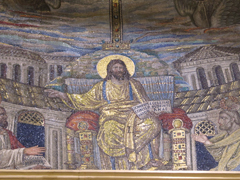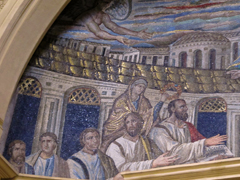SUN AN’ SOUL - DREAM AN’ ROME
SANTA PUDENZIANA
 |
| Santa Pudenziana - click to enlarge |
Santa Pudenziana was built in the second century AD on the domus (=palace) of Pudente, a Roman senator, father of the Saint. The church was heavily restored since 1585, while the façade was rebuilt after 1870.
However, in the trabeation, above the entrance portal, has been preserved a unique medieval relief, in which are depicted St. Prassede and Pudente to the right of the Lamb and St. Pudenziana with an unknown Saint to the left.
| Santa Pudenziana, the trabeation - click to enlarge |
 |
 |
 |
| St. Prassede and Pudente |
The Lamb |
St. Pudenziana with an unknown Saint |
The five orders bell tower dates back to the thirteenth century.
Inside, very suggestive thanks to the restoration that in 1930 brought to light the walls of the ancient domus, shines the apse mosaic which, dating back to the end of the fourth century, is one of the eldest in the Christian Rome.
 |
| Santa Pudenziana, the bell tower - click to enlarge |
Jesus appears in the center with around 10 apostles, the two that are missing are probably been deleted from the interventions of the XVI century.
In the open book that Jesus is holding you can read "DOMINUS CONSERVATOR ECCLESIAE PUDENTIANAE." (=Patron of Pudenziana church).
The two women holding out to Jesus a crown may be the two daughters of the Roman senator Pudente, St. Pudenziana and St. Prassede.
The city in the background is Jerusalem with the jeweled cross that Emperor Theodosius II erected there in 416. In the cloudy sky appear winged the four living creatures of Revelation: the angel, the lion, the bull and the eagle.
 |
 |
 |
| Santa Pudenziana, the apse mosaic - click to enlarge |
This mosaic has a great evocative power: the realism of the faces, as opposed to the abstract representations of the subsequent Byzantine art, shows the influence of the ancient Roman figurative art.
Still inside to admire the Caetani chapel, by Carlo Maderno, and the fresco of the dome by Niccolò Circignani, one of three painters who, to be born in Pomarance, were called Pomarancio.
 |
| Santa Pudenziana, the fresco of Caetani chapel - click to enlarge |
back |

